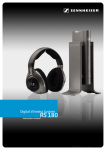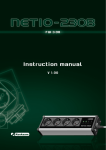Download Sennheiser RS 145 comfort Specifications
Transcript
Wireless Listening Pleasure RS 145 comfort Instruction mManual I 1 6 L 5 OFF ON 4 R BALANCE L 3 2 II 7 8 ON/OFF 9 E CHARGE 0 COMPRESSION INPUT LEVEL D C A OFF B ON Contents Contents Important safety instructions ................................................ 2 The RS 145 comfort RF headphone system ......................... 4 Delivery includes ...................................................................... 4 Product overview ..................................................................... 5 Putting the RS 145 comfort system into operation ............ 7 Setting up the transmitter .................................................... 7 Connecting the transmitter to a sound source ................. 8 Connecting the transmitter to the mains ........................... 9 Inserting and changing the headphones’ rechargeable batteries .................................................................................... 9 Charging the headphones’ rechargeable batteries ........ 10 Adjusting the headband of the headphones ................... 11 Using the RS 145 comfort system ....................................... 12 Switching the transmitter on and off ............................... 12 Switching the headphones on and off .............................. 13 Searching for a sound source .............................................. 14 Changing the transmission channel .................................. 14 Adjusting the signal of the sound source ........................ 15 Adjusting the volume ........................................................... 16 Adjusting the balance .......................................................... 16 Enhancing the speech intelligibility ................................... 16 Switching the acoustic signals (beeps) on and off ........ 17 Cleaning the RS 145 comfort system ................................. 18 If a problem occurs ... ............................................................ 19 Accessories and spare parts ................................................. 21 Specifications .......................................................................... 21 Manufacturer Declarations ................................................... 23 Index ........................................................................................ 24 1 Important safety instructions Important safety instructions • • • • • • • Read this instruction manual. Keep this instruction manual in a safe place. Always include this instruction manual when passing the system on to third parties. Clean the devices and the mains unit only with a dry cloth. WARNING: To reduce the risk of fire or electric shock, do not expose the devices and the mains unit to rain or moisture. Disconnect the mains connector from the wall socket – to completely disconnect the device from the mains, – during lightning storms or when unused for long periods of time. Only use the supplied mains unit. Ensure that the mains unit is – always readily operable and easily accessible, – properly plugged into the wall socket, – only operated within the permissible temperature range (see “Specifications” on page 21), – not covered or exposed to direct sunlight for longer periods of time in order to prevent heat accumulation. Intended use of the devices Intended use includes: • having read this instruction manual, especially the chapter “Safety instructions”, • using the devices within the operating conditions and limitations described in this instruction manual. “Improper use” means using the devices other than as described in this instructions, or under operating conditions which differ from those described herein. 2 Important safety instructions Safety instructions for NiMH rechargeable batteries If abused or misused, rechargeable batteries may leak. In extreme cases, they may even present: • • • • • a heat hazard, a fire hazard, a leakage hazard, an explosion hazard, a smoke or gas hazard. Please understand that Sennheiser does not accept liability for damage arising from abuse or misuse. Keep away from children. Only use original Sennheiser rechargeable batteries. Observe correct polarity. Do not short-circuit. Do not expose to moisture. Switch rechargeable batterypowered devices off after use. Do not pack charged batteries loose – danger of shorting out / fire hazard. When not using rechargeable batteries for extended periods of time, charge them regularly (about every three months). Do not continue to use defective rechargeable batteries. Do not heat above 70°C/158°F, e.g. do not expose to sunlight or throw into a fire. Do not mutilate or dismantle. Only charge rechargeable batteries at ambient temperatures between 10 °C and 40 °C. Immediately remove rechargeable batteries from obviously defective devices. Dispose of rechargeable batteries at special collection points or return them to your specialist dealer. Only charge rechargeable batteries with the appropriate Sennheiser chargers. 3 The RS 145 comfort RF headphone system The RS 145 comfort RF headphone system The RS 145 comfort RF stereo hi-fi headphone system offers excellent sound quality and allows for wireless listening everywhere in the house and garden. The lightweight headphones are extremely comfortable to wear and very easy to use. The volume can easily be adjusted to individual needs. The speech intelligibility can be enhanced on the transmitter. Enjoy a completely unrestricted listening experience without disturbing others. Delivery includes 1 HDR 145 headphones 1 TR 145 transmitter with connection cable 2 AAA size NiMH rechargeable batteries, 1.2 V 1 T-RS 100 mains unit 1 adapter 3.5 mm to ¼“ (6.3 mm) jack socket 1 instruction manual 4 Product overview Product overview An overview of the headphones and the transmitter is given on the inside front cover of this instruction manual. I Overview of the headphones 1 Headband 5 ON/OFF switch 2 Volume control 6 Earpad 3 TUNE button 4 Balance control for R/L volume adjustment II Overview of the transmitter 7 Charging cradle 8 Operation indicator , green 9 Charging indicator , red 0 Indicator for speech intelligibility and sound signal, yellow A COMPRESSION switch for speech intelligibility enhancement B Channel selector switch C Connection cable D Adapter for connection cable E Connector of mains unit 5 Product overview Overview of the indicators and acoustic signals Indicators on the transmitter Indicator Status Meaning Operation indicator 8 lit (ON/OFF) Sound source and transmitter are switched on. Charging indicator 9 (CHARGE) lit Rechargeable batteries are being charged. flashes Rechargeable batteries are fully charged. lit Speech intelligibility enhancement is switched on. Indicator for speech intelligibility (COMPRESSION) and sound signal (INPUT LEVEL) 0 flashes slowly Volume of sound source is adjusted too low. flashes rapidly Volume of sound source is adjusted too high. Acoustic signals and their meaning Acoustic signal Meaning 6 short beeps No signal! Transmitter is switched off or out of range. 6 2 long beeps Rechargeable batteries are almost flat. Sequence of 3 beeps Headphones have been switched off. Putting the RS 145 comfort system into operation Putting the RS 145 comfort system into operation Setting up the transmitter 왘 Choose a suitable place near your sound source (e.g. TV, stereo or home cinema system). 왘 Do not place the transmitter close to metal objects such as shelf bars, reinforced concrete walls, etc. as this can decrease the transmitter’s range, which is up to 150 m. It is not necessary that the transmitter and headphones are in the same room, so you can move around freely in the home or outside in the garden. One transmitter can be used to transmit to several headphones on the same frequency. Wall mounting the transmitter The transmitter is prepared for wall mounting. The required mounting hardware (screws and plugs) is not included in the delivery. 7 Putting the RS 145 comfort system into operation Connecting the transmitter to a sound source You can connect the TR 145 transmitter to different sound sources, such as a TV, a DVD player or a stereo system. 왘 Switch your sound source off. ' & 왘 Connect the connection cable C to the headphone socket of your sound source. If the plug on the connection cable C is too small for your headphone socket, plug the adapter to ¼“ (6.3 mm) jack socket D onto the connection cable. 왘 Adjust the volume of the headphone socket on your sound source to a medium level. This improves the quality of cordless sound transmission. If necessary, check the menu setting of your TV. With most TVs, the headphone socket is located at the front or sides. 8 Putting the RS 145 comfort system into operation Connecting the transmitter to the mains 왘 Connect the yellow connector of the mains unit E to the yellow socket on the transmitter. 왘 Plug the mains connector into a wall socket. The transmitter automatically switches on and the operation indicator 8 lights up. If there is no signal from the sound source for more than three minutes, the transmitter automatically switches off and the operation indicator 8 goes off. Disconnecting the transmitter from the mains 왘 Pull the mains connector out of the wall socket. Inserting and changing the headphones’ rechargeable batteries Before using the RS 145 comfort for the first time, you have to insert the supplied rechargeable batteries. 왘 Lift the left earpad 6 off as described under “Replacing the earpads” on page 18. 왘 Insert the rechargeable batteries. Observe correct polarity when inserting the batteries. 왘 Put the earpad 6 back in place. If the operating time decreases drastically even when the rechargeable batteries are fully charged, the rechargeable batteries are exhausted and have to be replaced. 9 Putting the RS 145 comfort system into operation Charging the headphones’ rechargeable batteries K Charge the rechargeable batteries for at least 16 hours prior to first time use. Subsequent charging time is about the same time as the previous operating time. The operating time is up to 23 hours. / &+$5*( 0'' 0/ 왘 Place the headphones on the charging cradle 7. Make sure that the charging indictor 9 lights up red. The headphones automatically switch off and the rechargeable batteries are being charged. Always store the headphones on the charging cradle 7 to ensure that they are fully charged when they are needed. When the rechargeable batteries are fully charged, the transmitter automatically switches to trickle charging and the charging indicator 9 flashes slowly. Nearly discharged batteries will significantly reduce the sound quality. Approx. 10 minutes before the batteries are completely discharged, an acoustic signal is produced. 10 Putting the RS 145 comfort system into operation Adjusting the headband of the headphones For good sound quality and best possible comfort, the headband has to be adjusted to properly fit your head: 왘 Wear the headphones so that the headband 1 runs over the top of your head. 왘 Adjust the length of the headband so that – your ears are completely inside the earpads, – you feel even, gentle pressure around your ears, – a snug fit of the headband 1 on the head is ensured. / 11 Using the RS 145 comfort system Using the RS 145 comfort system To switch the devices on and to listen to your sound source, proceed as follows: Sequence of steps 1. Make sure that the rechargeable batteries are charged. 2. Switch your sound source (e.g. TV) on. 3. Set the volume to a low level. 4. Switch your headphones on. 5. Set the desired volume. 6. If necessary, set a different channel for your sound source. Page 10 12 13 13 16 14 Switching the transmitter on and off Switching the transmitter on 왘 Switch your sound source on. The transmitter automatically switches on and the operation indicator 8 lights up. If the transmitter does not switch on: 왘 Increase the volume of your sound source and, if necessary, read the section “The transmitter does not switch on” on page 19. Switching the transmitter off 왘 12 Switch your sound source off. Using the RS 145 comfort system If there is no signal from the sound source for more than three minutes, the transmitter automatically switches off and the operation indicator 8 goes off. The transmitter is now in standby mode, its power consumption is very low so that it can remain connected to the mains. When not using the transmitter for extended periods of time, pull out the mains connector from the wall socket. In this case, however, the headphones’ rechargeable batteries will not be recharged. Switching the headphones on and off CAUTION! Hearing damage due to high volumes! Listening at high volume levels for long periods can lead to permanent hearing defects. 왘 Before putting the headphones on, set the volume to a low level (see page 16). 왘 Do not continuously expose yourself to high volumes. Switching the headphones on 왘 Set the ON/OFF switch 5 on the headphones to the position ON. The headphones switch on and automatically start the channel search on the last selected channel. If a channel is found, the channel search stops. You hear the signal of the found sound source. If you do not hear the sound source after a short while, please refer to the chapter “If a problem occurs ...” on page 19. 13 Using the RS 145 comfort system Switching the headphones off 왘 Set the ON/OFF switch 5 on the headphones to the position OFF. The headphones switch off. Always store the headphones on the charging cradle 7 to ensure that they are fully charged when they are needed. Searching for a sound source 왘 Make sure that the operation indicator 8 on the transmitter is lit. If you do not hear the desired sound source, continue the search: 왘 Press the TUNE button 3 on the headphones until you have found your sound source. 왘 If you cannot find your sound source, please read the following section. Changing the transmission channel If several transmitters are operated simultaneously and are very close to one another, the sound quality can deteriorate and you hear e.g. hissing noise. To improve the sound quality, change the transmission channel: 14 Using the RS 145 comfort system 왘 Set the channel selector switch B on the transmitter to channel 1, 2 or 3. % To set the headphones to the selected channel: 왘 Press the TUNE button 3 on the headphones. Adjusting the signal of the sound source The transmitter automatically ensures that the headphones always receive an optimum signal. However, the signal of the sound source can be so weak or so strong that it can no longer be automatically adjusted. Signal of the sound source is too weak If the signal of the sound source is too weak, the indicator for speech intelligibility and sound signal 0 flashes slowly. 왘 Gradually increase the volume of your sound source until the flashing stops. If the signal of the sound source is too weak, an optimum transmission is not possible. It could be that the transmitter switches off after some time. Please refer to the chapter “If a problem occurs ...” on page 19. Signal of the sound source is too strong If the signal of the sound source is too strong, the indicator for speech intelligibility and sound signal 0 flashes rapidly. 왘 Gradually reduce the volume of your sound source until the flashing stops. 15 Using the RS 145 comfort system Adjusting the volume 왘 Use the volume control 2 to adjust the volume to a sufficient and comfortable level. Adjusting the balance The balance control allows for right/left volume adjustment. Adjust the balance so that you hear equally well with both ears. 왘 Turn the balance control 4 to the left L or right R in order to increase the volume for the corresponding ear. There is a click-stop in the center position. Enhancing the speech intelligibility The RS 145 comfort features a dynamic compression system which allows you to enhance the speech intelligibility. This system evens out volume differences, i.e. it reproduces soft passages louder and decreases loud sounds. 왘 16 Set the COMPRESSION switch A on the transmitter to the position ON. The indicator for speech intelligibility 0 lights up. Using the RS 145 comfort system Switching the acoustic signals (beeps) on and off An overview of the acoustic signals is given on page 6. The acoustic signals can be switched on and off as follows: 왘 Switch the headphones on (see page 13). 왘 Press the TUNE button 3 for 5 seconds. 왘 Switch the headphones off for testing (see page 13). If the acoustic signals are switched on, the headphones produce a sequence of three beeps at switch-off. If no beeps are produced, the acoustic signals are now switched off. The setting for the acoustic signals is retained in memory until you change the setting again or replace the rechargeable batteries. 17 Cleaning the RS 145 comfort system Cleaning the RS 145 comfort system CAUTION! Liquids can damage the electronics of the devices! Liquids entering the housing of the devices can cause a short-circuit and damage the electronics. 왘 Keep all liquids far away from the devices. 왘 Do not use any cleansing agents or solvents. 왘 Before cleaning, switch the devices off and disconnect the transmitter from the mains. 왘 Only use a slightly damp cloth to clean the devices. Replacing the earpads For reasons of hygiene, you should replace the earpads from time to time. Spare earpads are available from your Sennheiser dealer (see “Accessories and spare parts” on page 21). 왘 To loosens the quarter turn fastener which secures the earpads to the earcups, turn the earpads 6 in the direction of the arrow until you overcome a slight resistance. 왘 Lift the earpads 6 off the earcups. 18 If a problem occurs ... If a problem occurs ... The transmitter does not switch on Possible cause Solution Is the mains unit connected correctly? Check the connection of the mains unit to the transmitter and to the mains. Is the volume of the Set the volume on your sound source sound source to a medium value. sufficient? Page 9 12 You cannot hear anything Possible cause Solution Is the transmitter placed close to metal objects? Choose a different place for the transmitter. Make sure that the transmitter is not placed close to metal objects. Page 7 Are the headphones Move the headphones closer to the still within the transmitter. If necessary, switch the transmitter’s range? headphones on again. 7 Are all connectors connected correctly? Check the connection between the transmitter and your sound source. 8 Is the operation indicator 8 lit? Check if the transmitter is switched on. 12 Are the rechargeable batteries charged? Place the headphones on the charging cradle. Check the charging indicator. 10 Are the rechargeable batteries properly inserted? Remove the rechargeable batteries and reinsert them into the headphones. 9 19 If a problem occurs ... You can hear the sound only with one ear Possible cause Solution Is the balance adjusted correctly? Turn the balance control 4 to the left or right. Page 16 The sound of your sound source is hardly intelligible Possible cause Solution Page Is the speech intelligibility enhancement deactivated? Slide the COMPRESSION switch A to the right. 16 You do not hear your desired channel? Press the TUNE button 3 on the headphones to start the search for your desired channel. 14 Is there another transmitter operating in the proximity? Set the transmitter to a different channel and press the TUNE button 3 on the headphones. 14 The loudspeakers of your TV are muted Possible cause Solution Some TVs have a function that mutes the loudspeakers when you connect a transmitter. Via the operating menu of your TV, check if and how the muting function can be deactivated. Alternatively, use a different audio socket on your TV. If a problem occurs that is not listed in the above tables or if the problem cannot be solved with the proposed solutions, please contact your Sennheiser partner for assistance. 20 Accessories and spare parts Accessories and spare parts Only use original Sennheiser accessories and spare parts, otherwise the device quality can be impaired or the devices can be damaged. Cat. No. Accessory/spare part 502821 1 HDR 145 additional headphones 511792 1 pair of earpads Specifications RS 145 comfort system Modulation Frequency range Frequency response Signal-to-noise ratio Ambient temperature FM, stereo 863 – 865 MHz 18 – 21,000 Hz typ. 68 dB (A) 0 °C to +40 °C TR 145 transmitter Carrier frequencies Radiated RF power Power supply Power consumption Channels Connector 863.3 / 864.0 / 864.7 MHz ≤ 10 mW 9 V DC via NT-RS 100 mains unit < 1.8 VA 3 3.5 mm stereo jack plug 21 Specifications TR 145 transmitter Weight Dimensions (incl. charging cradle) approx. 430 g approx. 85 x 133 x 225 mm (W x D x H) HDR 145 headphones Transducer principle Max. SPL (at 1 kHz) THD (at 1 kHz) Power supply Charging time Operating time Weight dynamic, circumaural, closed 110 dB < 0.5% 2 AAA size NiMH rechargeable batteries (LR 03) approx. 16 hrs (full charge) up to 23 hrs (with fully charged rechargeable batteries) approx. 280 g incl. rechargeable batteries NT-RS 110 mains unit Nominal input voltage Mains frequency Nominal output voltage Nominal output current Operating temperature range 230V AC 50 Hz 9 V DC 200 mA 0 °C to +40 °C Transmitters that operate in the 863 – 865 MHz frequency range can be used licence-free in the following countries: AT, BA, BE, CH, CY, CZ, DE, DK, EE, ES, FI, FR, GB, GR, HU, IE, IS, IT, LI, LT, LU, LV, ME, MK, MT, NL, NO, PL, PT, RO, RS, SE, SI, SK, TR, UA. 22 Manufacturer Declarations Manufacturer Declarations Warranty Sennheiser GmbH & Co. KG gives a warranty of 24 months on this product. For the current warranty conditions, please visit our web site at www.sennheiser.com or contact your Sennheiser partner. CE Declaration of Conformity This equipment is in compliance with the essential requirements and other relevant provisions of Directives 2006/95/EG and 1999/05/EG. The declaration is available on the internet site at www.sennheiser.com. Before putting the equipment into operation, please observe the respective country-specific regulations! Rechargeable batteries The supplied rechargeable batteries can be recycled. Please dispose of them as special waste or return them to your specialist dealer. In order to protect the environment, only dispose of exhausted batteries. WEEE Declaration Your Sennheiser product was developed and manufactured with high-quality materials and components which can be recycled and/or reused. This symbol indicates that electrical and electronic equipment must be disposed of separately from normal waste at the end of its operational lifetime. Please dispose of this product by bringing it to your local collection point or recycling centre for such equipment. This will help to protect the environment in which we all live. 23 Index Index Headphones Adjusting the balance 16 Adjusting the volume 16 Automatic channel search 14 Charging the headphones 10 Cleaning 18 Operating elements of the headphones 5 Operating time 10 Replacing the earpads 18 Searching for a sound source 14 Switching the acoustic signals on/off 17 Switching the headphones on/off 13 Rechargeable batteries Changing the batteries 9 Charging indicator 6 Charging the batteries 10 Transmitter Adjusting the signal of the sound source 15 Changing the channel 14 Cleaning 18 Connection to a headphone socket 8 Connection to a sound source 8 Connection to the mains 9 Enhancing the speech intelligibility 16 Installation 7 Operating elements of the transmitter 5 Switching the transmitter on/off 12 Troubleshooting 19 24 Sennheiser electronic GmbH & Co. KG Am Labor 1, 30900 Wedemark, Germany www.sennheiser.com Printed in China Publ. 09/08 532002/A01







































